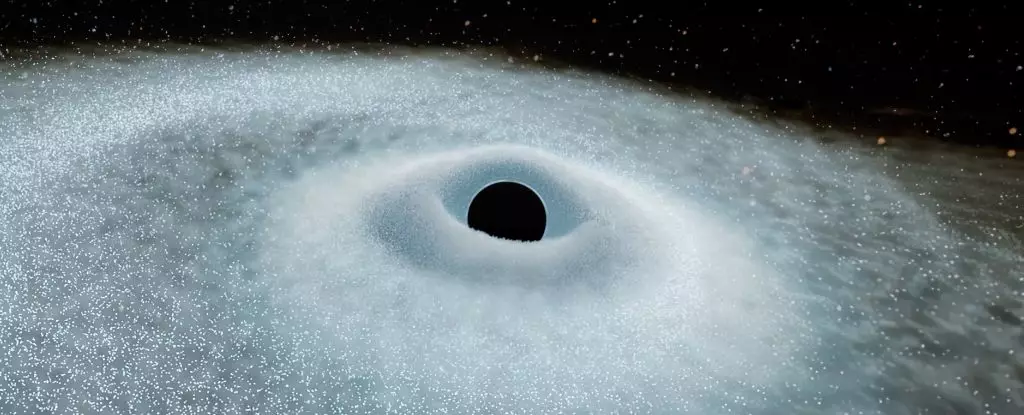In an extraordinary turn of events, scientists utilizing the Gaia space telescope have stumbled upon a groundbreaking discovery that is shaking the very foundations of astrophysics. Known as extreme nuclear transients (ENTs), this newly identified phenomenon represents a colossal category of astronomical explosions massively brighter than previously recorded cosmic events. Captured from the depths of distant galaxies, these luminescent eruptions not only challenge our understanding of black hole interactions but also open new avenues for astronomical exploration, aiming to illuminate the complex mechanics of the universe.
The ability of the Gaia telescope to monitor the cosmos has once again proven crucial. Initially designed to create a detailed three-dimensional map of the Milky Way, Gaia’s sophisticated imaging capabilities allowed it to record significant bursts of light that can only be described as stellar beacons echoing through time. Each flare observed during this study corresponds to immense energy releases—comparable to that of 100 Suns over their entire life cycles—indicating that we are witnessing not ordinary cosmic events, but extraordinary interactions between massive stars and black holes, only first theorized in the realm of astrophysics.
Breaking Down the Mechanism Behind ENTs
At the heart of these ENTs lies a process commonly referred to as tidal disruption events (TDEs), where stars drawn too close to supermassive black holes are ultimately torn apart by the monstrous gravitational forces at play. However, what sets ENTs apart is their unprecedented brightness and longevity, staying luminous for years, far surpassing the energy output of even the most radiant supernova explosions known to us. Astrophysicists, including Jason Hinkle from the University of Hawai‘i, emphasize that these newly uncovered ENT phenomena could revolutionize our understanding of cosmic destruction and formation.
Previously, stellar explosions followed a predictable pattern: a sudden, intense brightening followed by a gradual dimming over weeks to months. However, the ENTs challenge these norms, with their brightness soaring to levels ten times greater than standard TDEs and remaining visible for extended periods. This spectacular flare is not merely an exhilarating cosmic light show; it is a treasure trove of information waiting to be unveiled. Scientists analyzing this light can extract vital details regarding the masses involved, illuminating the intricate dynamics of cosmic entities that were once elusive.
The Cosmic Puzzle and Its Implications
Understanding ENTs might also aid astronomers in deciphering the evolution of supermassive black holes, those colossal entities that can be millions or even billions of times the mass of our Sun. Despite our extensive research into these astronomical titans, their formation and growth remain shrouded in mystery. The serendipitous discovery of ENTs provides a new framework for studying how these black holes can amass mass on such a monumental scale.
As astrophysicist Benjamin Shappee suggests, the brightness of ENTs offers a rare opportunity to witness the history of these distant galaxies unfold, as light from such events takes eons to reach us. Therefore, studying ENTs not only enriches our understanding of black holes but also enhances our perception of the universe’s timeline. What was once deemed speculative now feels tangible, ushering in an era of discovery that allows us to glimpse into the cosmos’ past.
Rethinking Astronomy’s Approach to Cosmic Events
The rarity of ENTs—estimated to occur approximately every 10 million years compared to supernovae—further underlines the significance of these findings. While many astronomical events are routinely documented, ENTs offer valuable insights that could reshape our approach to cosmic research. Engaging with these extraordinary occurrences may reveal new gravitational dynamics, redefine our models of stellar evolution, and expand our comprehension of cosmic matter.
Furthermore, the way ENTs bridge the gap between astronomical observation and theoretical models prompts researchers to rethink conventional paradigms in celestial mechanics. It raises stimulating questions: What other unknown phenomena might lie hidden in the universe, just waiting for a sharp-eyed observer to notice? What further mysteries of black holes remain to be unraveled? As scientists delve deeper into studying ENTs, they could uncover patterns or processes that challenge the fundamental principles we hold about the universe.
In light of this astonishing discovery, it is evident that we stand on the precipice of a new cosmic frontier. With each advancing study, we inch closer to understanding the grandeur and complexity of our universe. There’s no denying the excitement generated by ENTs, as they not only captivate our imagination but also ignite a fervor for continued exploration into the wonders and secrets that lie beyond our reach.

